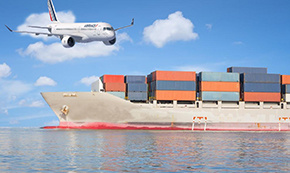All categories >
New US Customs Regulations Upgraded! Involving Inspection of Full Container Loads
Categories:
News Center
News
Time of issue:
2025-08-22 12:19
Views:
On August 14 local time, the U.S. Customs and Border Protection (CBP) issued a notice announcing that starting from August 25, 2025, there will be major adjustments to the inspection and transportation process of container cargo at the Los Angeles/Long Beach port (LA/LB). This measure aims to address the recent frequent issues of evading customs inspections and strengthen cargo supervision.

Core content of the new regulation
Mandatory control of Full Container Load (FCL) inspection transportation: For full containers selected by the Merchandise Enforcement Team (MET) or Agricultural Quarantine Inspection (AQI), customs brokers and importers are prohibited from independently choosing trucking companies for transfer. Transportation between the terminal and the inspection site, including mandatory return shipments and transport from the inspection site back to the loading terminal, must be carried out by designated trucking companies contracted through the Centralized Examination Station (CES).
Less than Container Load (LCL) cargo retains transportation flexibility: LCL cargo, meaning containers with multiple importers' goods, is not required to be picked up at the inspection station. Customs brokers and importers can still arrange transportation from the terminal to the inspection site independently, but specific pickup arrangements must comply with customs requirements.
Background of the new regulation
Recently, there have been frequent incidents of inbound cargo evading customs inspections. Some companies exploited their transportation autonomy to change labels during transfer, dismantle containers to hide sensitive goods, and even forge CES delivery records, seriously disrupting customs supervision. As a result, port operators demanded the implementation of "controlled drayage transportation."
This adjustment has a clear legal basis, originating from Title 19 CFR §151.15(d), which grants customs the authority to designate types of carriers and mandate the use of specific CES sites.
There are two major regulatory departments under U.S. Customs. One is the Agricultural Quarantine Inspection (AQI), under CBP, operating according to USDA's Animal and Plant Health Inspection Service regulations, focusing on preventing pests and illegal agricultural products from entering, with emphasis on undeclared seeds, live plants, etc. The other is the Merchandise Enforcement Team (MET), also under CBP, which ensures compliance of imported goods through manual inspections, often cooperating with agencies like the FDA, focusing on electronics, children's products, counterfeit goods, and misdeclared cargo.
Impact on timeliness between old and new models
Original full container inspection process (before August 25, 2025) , Customs brokers could independently arrange trucking companies with Bonded warehouse qualifications, allowing flexible transportation allocation. Container pickup required application to the terminal, and transportation to designated CES usually required a 1-3 day appointment. After CES arranged unpacking, goods typically stayed 3-7 days on average, with inspection fees and storage charges paid at the end.
New regulation effective from August 25, 2025 , Customs brokers and importers lose transportation autonomy and must mandatorily use CES-contracted trucking fleets. CES coordinates container pickup, extending dispatch times. Limited inspection site capacity delays cargo entry into inspection, slowing overall inspection duration. During peak seasons, CES's monopoly on trucking resources may cause "queueing for container pickup." This significantly affects time-sensitive goods such as fresh produce and seasonal products, requiring an additional 3-5 day buffer period for full container shipments to cope with possible delays.

Recent enforcement priorities of U.S. Customs
In combating illegal drugs and health-threatening items , In early August 2025, CBP and FDA jointly conducted a nationwide enforcement week with remarkable results, seizing 54,843 unapproved drug items. Typical prohibited items included unapproved weight loss injections, botulinum toxin, and contact lenses, with shipments mainly from Hong Kong, Mainland China, and South Korea.
Strict enforcement against anti-dumping and tariff evasion is also a focus. From January to August this year, CBP launched investigations under the Enforcement and Protection Act (EAPA), uncovering 89 tax evasion cases and recovering over $400 million in unpaid duties. Some companies illegally transshipped goods to third countries to disguise origin and evade tariffs. The largest case involved 23 importers transshipping Chinese goods through countries like Indonesia, with recovered amounts reaching $250 million.
Additionally, high-frequency categories of intellectual property infringement remain under scrutiny, with clothing, jewelry, and sports equipment as key inspection targets. In 2024, CBP intercepted nearly 20,000 infringing items, with children's toys and Bluetooth earphones as major infringement hotspots.
Response strategies
Logistics arrangements , Allow sufficient lead time. Plan shipments in advance, adding a 3-5 day buffer for full container transport to prevent stockouts caused by CES scheduling delays. Also consider splitting shipments to disperse inspection risks.
Ensure declaration information is accurate , Cargo descriptions, quantities, values, and customs codes must match actual details, avoiding vague or incorrect statements to prevent customs inspection issues.
Strengthening compliance pre-screening mechanisms is crucial 。 For AQI-sensitive goods, ensure wooden packaging has IPPC fumigation marks and agricultural products carry origin health certificates; for MET high-risk items, prepare FDA registration numbers, FCC certifications, CPSC test reports for children's products, and other necessary documents in advance.
Additionally, choose professional logistics service providers 。 They are familiar with U.S. customs inspection processes and requirements, can assist in preparing customs clearance documents, handle emergencies, provide more reliable services to sellers, and reduce risks of cargo loss, damage, and delays.
Keywords:










